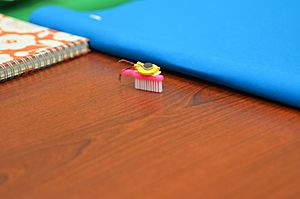Bristlebot facts for kids
A bristlebot (also called a brushbot) is a super simple type of walking robot. It's one of the easiest mobile robots to understand and build. Because they are so easy to make, bristlebots have become very popular projects for school science fairs!
Contents
How Bristlebots Move
A bristlebot has a simple, solid body. Its bottom surface is covered in bristles, just like a brush. These bristles are angled in one main direction. This angle gives the robot a preferred "forward" direction.
The robot moves by vibrating its body. These vibrations make the bristles push against the surface. This causes the robot to slowly move in the direction the bristles are angled. It's a bit like how tiny flagella (tail-like parts) help bacteria move.
Most bristlebots use electricity to move. They use small motors and batteries. Because bristlebots move in a simple way, they usually don't have complex control systems. They are not designed for very fancy movements.
What are Vibrobots?
A vibrobot is a robot similar to a bristlebot. But instead of brush bristles, it uses springy wire legs to move.
Vibrobots powered by clockwork (like old clocks) or elastic motors (like rubber bands) have been around for a long time. They were made even before electric bristlebots. The Brazilian designer Chico Bicalho has often featured them in his work.
Building Your Own Bristlebot
Building bristlebots became popular in the mid-2000s. This was when small vibrate motors from cellphones became cheap and easy to find. You could get them from old pagers or cellphones. These motors are perfect for bristlebots because they are powerful and light.
A typical homemade bristlebot usually has only three main parts:
- a toothbrush head
- a vibrate motor
- a small lithium coin cell battery
You can use glue, tape, or tie-wraps to put the parts together.
You need to pick a toothbrush with a flat surface. Most of its bristles should point in one direction. Old, worn toothbrushes often don't work well. Their bristles might stick out in every direction. This can make the bristlebot just spin or shake without moving forward. Some new brushes might have very straight bristles. You might need to trim them to create a slope for better movement.
Bristlebots for Science Projects
Building bristlebots in groups is a popular science project for kids. It's often done in schools, at Maker Faires, and similar events.
You can buy kits that make assembly easier and add decorations. However, these kits are not really needed. You can easily build a bristlebot with simple parts you might already have.
Famous Bristlebots: Hexbug Nano
The popular Hexbug line of toy robots started with the Hexbug Nano. This was a type of bristlebot. The Nano V2 came out in 2013. It was an improved version of the original Nano. It has three extra flexible spines on its top. These spines let it climb straight up between two close walls or inside tubes.
Because the top spines are in a narrow row, the 'bots are unstable if they flip upside down. This means they can flip themselves back over.
Many clear plastic tube habitats are sold with Hexbugs. These range from simple vertical tubes to show climbing. They also include larger habitats with many horizontal areas. These areas are connected by curved climbing tubes made of clear plastic. You can also buy other construction set tube parts. These include twisted tubes and funnels.


